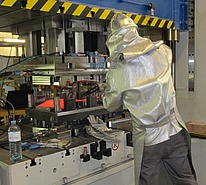Hot Forming (DIN 8582)
Forming after heating. Hot forming comprises forming steps, which take place above the recrystallization temperature of the metal. Hot forming results in a large formability of the material and lower forming forces. Hot forming processes can be, among others:- Forging
- Hot rolling
- Extrusion pressing
- Press hardening/hot stamping
Hot Stamping
Hot stamping, also denominated as press hardening, is a relatively new production process in the field of car-body construction. In press hardening, a sheet blank is heated up to a temperature between 870 and 950 °C and cooled down during the forming step. 22MnB5 is the used material for this process. Due to scale formation, different coatings are applied (AS, Z, GP, ZF, x-tec). In line with the research activity at the Institute T&F, the following projects regarding direct press hardening have been conducted so far:- Press hardening of 22MnB5 with different coatings (AlSi, Zn,uncoated) and subsequent part characterization
- Press hardening of laser-welded contoured plates (Tailor Welded Blanks)
- Construction of a tool with integrated cooling system
- Thermo-mechanic process simulation
Contact
Institute of Materials Science, Joining and Forming
Research Group of Lightweight and Forming Technologies
Inffeldgasse 11/I
8010 Graz
Tel.: +43 (0) 316 / 873 - 9441
Fax: +43 (0) 316 / 873 - 9442
office.lft@TUGraz.at


